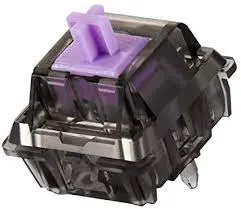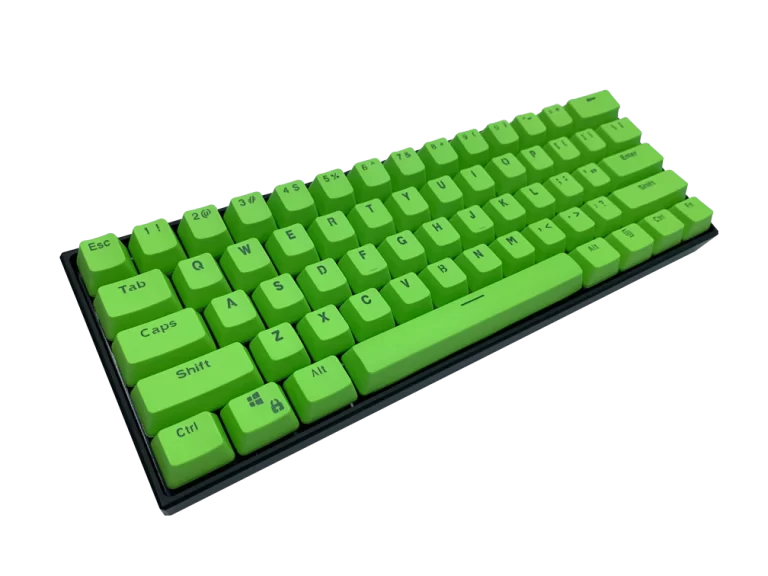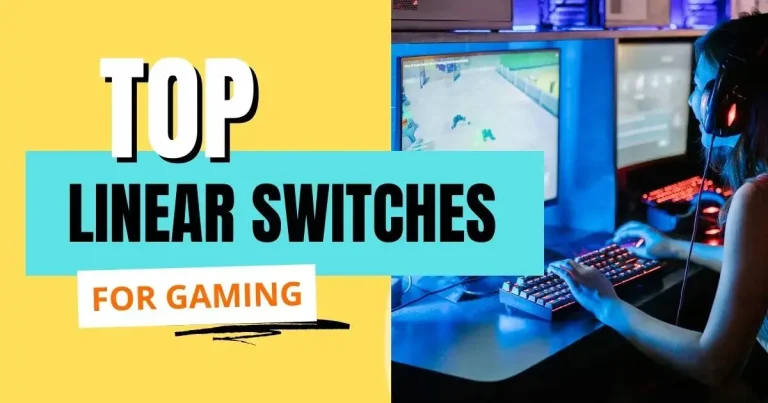Are Blue Switches Good For Gaming in 2023? Ultimate Guide
Choosing a suitable game controller can be very difficult. It is essential to be able to choose the right gaming switch with the ability to provide optimum performance for gaming. Are blue switches good for gaming?. You can find the answer to this question and should pick the best gaming linear switches for mechanical keyboards to enhance the gaming experience. It’s imperative that you can enjoy playing your gaming keyboard without a number pad.
Blue switches are great for gaming because they are easier to use. There are various models of gaming controllers, like cherry MX blue switches, which are great for FPS games. You can get FPS controllers made of wood, plastic, steel, and titanium. These gaming controllers are great for first-person shooters because you can easily find the right buttons and sticks.

Linear Switches
A few types of switches are used in in-game controllers, including those with blue switches. These are called ‘click’ switches because they allow the user to click on them. These switches are usually used in games that require the player to click rapidly.
The click switch is considered one of the fastest click switches available. Many users prefer them because they require less effort to actuate than their counterparts. In addition to that, click switches are very quiet and silent. However, the main advantage of using these switches is that the user does not get tired quickly.

Other click switches are not as comfortable, primarily when used for a long time. The user might get tired and even get blisters on their hands.
Are Blue Switches Good for Gaming? Mechanical Keyboards Complete Guide
Switching between different keys can make it difficult for you to play your favorite games. One of the main reasons why you’d need to buy a new keyboard is to change its color. If you like the blue switches, you can buy a keyboard with the feature. Some keyboards that come with the quality are the Corsair K90 RGB, the Corsair Vengeance K60, the Corsair Vengeance M60, and the Logitech G710+ Spectrum Spectrum Core, and the Razer BlackWidow Ultimate. However, these mechanical keyboards are usually expensive, and some are not designed for gamers.
Black Switches
Most of the popular keyboards use Cherry MX blue switches. These are good for gaming because they are quiet and reliable but can be noisy. If you want a quieter keyboard, you can use black switches instead. Black switches are better suited for clicky switches to write. You can use brown or red switches instead if you want to go with something different. clicky switches are better suited for typing, while red switches are more comfortable and can withstand higher pressure than the other types.

The blue switch has a very unique and distinctive feel. A typical blue switch comprises a pair of microswitches usually placed below the main switch on the board. This type of switch is known as the mechanical switch. Some keyboards also come with red switches. These switches are very similar to blue switches, but the red ones are slightly smaller and lighter. Red switches are usually found in some laptop keyboards.
Blue switches have a unique look to them and can also produce a high-pitched beep when pressed on clicky switches. Because blue switches are mechanical, they require a lot of force to press them down. They are suitable for gamers who need to click quickly, but you should always take care when using them.
Brown Switches
A blue switch will click when you press it down firmly. You should press them lightly and slowly. You should also press them down firmly when you are playing FPS games. The linear optical switches and mechanical switches would help if you also pressed the keys evenly and steadily.

A good pair of headphones can improve the sound quality of the game. The best option is one that has a good design and a large sound hole. The ear cups should fit tightly to block out extraneous noises. You should avoid buying cheap headphones that cost less than $10. These headphones may not be excellent. To be a gamer, you should buy a good pair of headphones. The sound quality of your headphones will significantly affect your gaming experience.
Which Switches are Bad for Competitive Gaming? Are Blue Switches Good for Gaming?
Blue switches have been used for many years in mechanical switches because they make games more exciting. You will be able to play with a lot of buttons when you use these switches. However, they also come with downsides. They can be more susceptible to damage than standard switches. For example, if you are playing a first-person shooter game, you must wipe down your keyboard regularly to avoid contamination. The same goes for your mouse.
Brown switches are also not suitable for tactile switches in gaming. This is because they usually have a rubber dome instead of a plastic one.
To get the best out of your computer’s keyboard, you should look for a keyboard that has a good quality switch. These switches will also work on all the keyboards that have a brown switch.
You might not have to do this using a keyboard with green switches. Green switches are less susceptible to getting dirty because they have a metal dome. They are also quieter than the blue ones.
My Opinion About Blue Switches for Gaming
Are blue switches good for gaming? I would say yes, they are. You don’t have to worry about whether your switch will break, and the durability of a blue switch is greater than that of other tactile switches.
They are also cheaper. If you want to change the switch, you don’t have to pay for a new switch. It’s easier to use a blue switch than a black one. This is because you won’t need to move the key while pressing it.
Pros and Cons of Blue Switch
I prefer blue switches for gaming because they are easy to switch, and I like the sound. They have a loud click when I press them. There is no clicking noise with red switches.
I use blue switches because they are easier to use. My first mechanical keyboard didn’t have them. The problem was that I couldn’t tell which key was being pressed. Using blue switches makes it easier to tell which key you are packing. I also love the loud clicks of the blue switches.
When I first started gaming, I had to learn how to program, which was a pain. I also had to read manuals to find out how to program. Using blue switches made programming much easier and faster.
Blue switches provide a more robust click sound. If you like games, it is good to have blue switches. I have been using blue switches since I began to play video games. Most gamers agree that it is easier to play games with blue switches. Most people don’t like to change keys and remap. This can be unpleasant if you are a gamer who wants to customize your keyboard. However, you can map keys to your liking. The only disadvantage of blue switches is that they cost more than others.
Pros
Clicky Feel
Most people don’t know this, but gamers are popular. They are straightforward to press. These switches make it easy to play video games. For me, it has been easier to press the buttons when the lights are blue. I can use these switches to turn on the TV, play music, change the volume, change the channels and change the lighting.
If you use these switches to control your home appliances, it will be much easier for you. If you are a gamer, you may want to use these switches because they are more comfortable to play on.
Excellent Operating Force and Actuation
The operation force of keys is brilliant. You can hold the key firmly and press it carefully. If you press the key with the right amount of pressure, you will be able to see what you demand, and you will be able to do the command you want.
Accurate Clicks
When you press a key, you get feedback about whether you have packed it or not. For example, positive feedback means that the key has been pressed. On the contrary, negative feedback means you haven’t pressed the key. You can use your fingers to feel the response to know whether the key is pressed or not. In the case of a reed switch, you will receive positive feedback immediately after pressing the key.
Cons
Extremely Noisy
Blue switches are considered the best option for gaming because they are more sensitive than red switches. They are usually used for FPS games, where many movements must be done quickly. Positive feedback is provided to the player immediately after pressing a key. This will make him focus on the game and not on the keyboard. Blue switches also reduce the number of false positives because they do not provide any feedback at all. This helps you to concentrate on the game instead of looking at the keyboard.
You can use a blue switch with many keys to play a fast-paced game. However, there are a few downsides to using blue switches.
Red switches are known for their durability, reliability, and long lifespan. They are the most commonly used switches out there. But sometimes, the switches can get worn out because of high usage. If you’re tired of repeatedly using the same red switch, it is a good idea to replace it with a new one.
If you’re looking for a new keyboard with better and more reliable keys, blue switches may be what you’re searching for. Blue switches are popular because they are much more responsive than red switches. They can detect whether you’ve pressed the key or not. This is useful in games, especially MMO games. You can use your fingers to feel the response to know whether the key is pressed or not.
Greater Travel Distance
If you want to play MMO games, you might want to consider getting a new keyboard with blue switches. Blue switches are very responsive to pressure. They can sense when you’re pressing a key or not. This makes playing MMO games a lot more fun. It can give you a lot of control over your character, too. In MMO games, you have to use your skills constantly. For example, you must press the attack key if you are fighting someone.
If you are trying to avoid an attack, you need to press the block key. This can be very frustrating if you are using a red switch. Blue switches are very effective in this scenario. This makes them the most popular switches among gamers.
Are Blue Switches Good For Gaming Multiplayer FPS?
Blue switches are not perfect for gaming because they require a lot of force before the player gets to hear the sound of the keyboard. This makes it difficult for them to chat and make the necessary adjustments. Besides this, the keys are spaced apart and require a lot of force before they are pressed. So, it is better to use black switches instead of blue ones for gaming.
It is straightforward to switch from chatting to playing games. Some keyboards can detect the current match. They can automatically switch between games or change to another after some time.
Components of Blue Switches
The first component of the keyboard is the keycap. It is made of rubber. The second component of the keyboard is the stem. It is also made of rubber. The third component of the keyboard is the upper housing. It holds the keycap, the stem, and the coil spring together. The fourth component of the keyboard is the coil spring. It keeps the keycap and the base housing in place.
- Keycap
- Stem
- Upper Housing
- Coil Spring
- Base Housing
- Crosspoint Contact
Characteristics of Blue Switches
Keycaps are one of the essential parts of a keyboard. They provide tactile feedback when pressed. They allow you to type comfortably with your fingers and also help you to play the game comfortably. It will enable you to type comfortably.
The second component of the keyboard is the stem. It holds the keycap, the stem, and the coil spring together. The fourth component of the keyboard is the coil spring. It keeps the keycap and the base housing in place.
Conclusion
In conclusion, the switches that are used for gaming are primarily red and blue. The blue and black switches are suitable if you use your keyboard for typing. However, they are also slightly more expensive than the other two. If you want to use a keyboard for gaming, you should use the red switch keyboard. If you want to type only, the best option is to use the blue switch keyboard.







